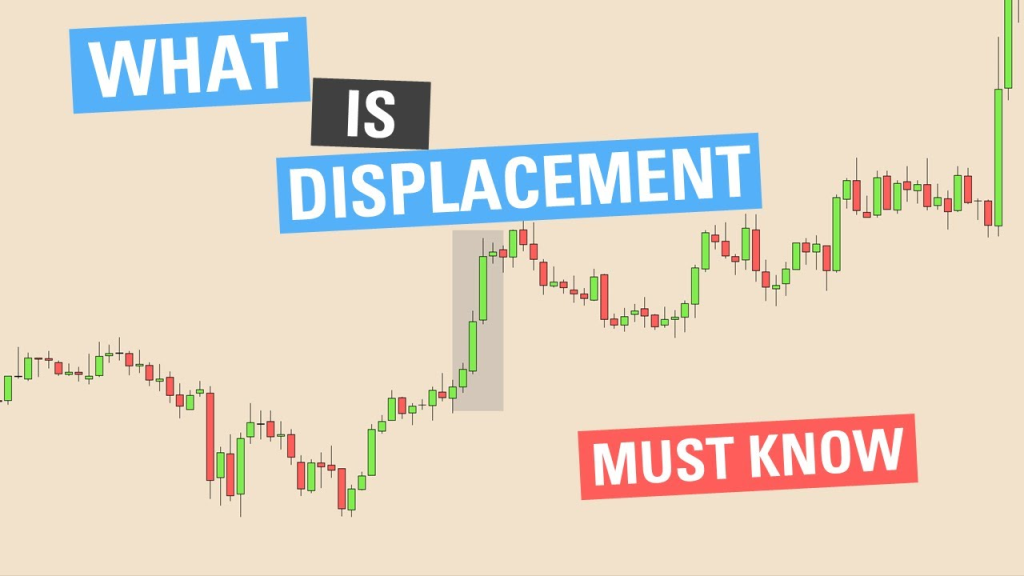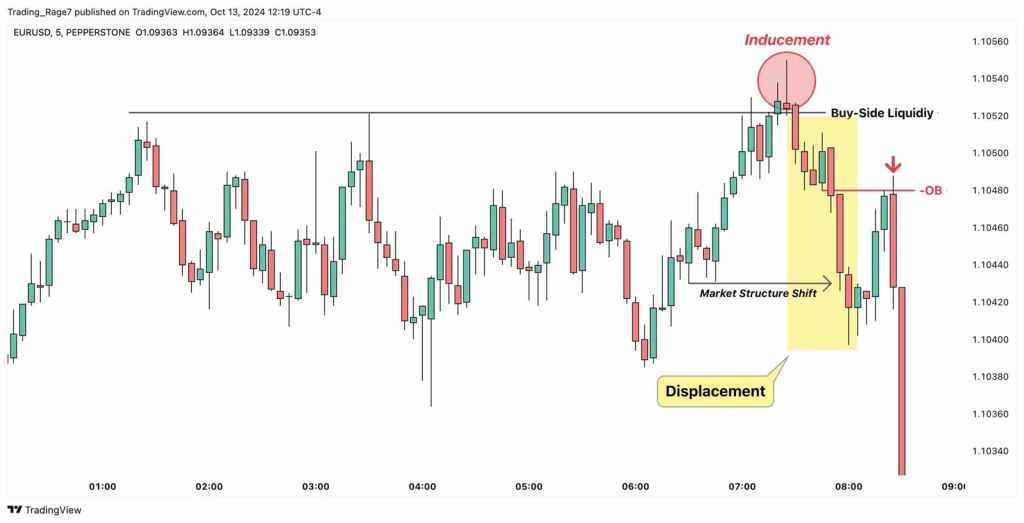
In Inner Circle Trader (ICT) concepts, a displacement move refers to a sharp and aggressive price movement that clearly breaks through key market levels, such as previous highs, lows, or structural points.
This type of move is often driven by institutional traders (or “smart money”) and is characterized by its strong momentum, leaving little room for retracement in the short term.
Displacement is a key signal that smart money has taken control of the market, and it helps traders identify potential high-probability entries.
Let’s explore displacement in detail, including how it works, why it happens, and how traders can use it in their strategies.
1. What is a Displacement Move in ICT?

A displacement move is essentially a market move that occurs with speed and force, indicating a shift in control from one side of the market (buyers or sellers) to the other.
This move often:
- Breaks significant levels (such as market structure points like swing highs or lows).
- Creates inefficiencies in the market, such as fair value gaps (FVGs).
- Shows clear dominance of smart money institutions over retail traders.
Displacement is most often seen after periods of consolidation or during times when the market is “rebalancing” after a liquidity sweep.
This makes it a crucial concept for traders looking to enter in line with institutional order flow.
2. Characteristics of a Displacement Move in ICT

Displacement moves are marked by the following key features:
1. Speed and Aggression:
The move happens quickly, often within a few candles, and breaks through key levels with little opposition.
2. Volume:
Displacement is often accompanied by a surge in trading volume, signaling the presence of large institutional orders.
3. Market Structure Shift (MSS):
It typically breaks the existing market structure, signaling the beginning of a new trend or the continuation of an existing one.
4. Fair Value Gap (FVG):
A displacement move leaves an imbalance (also known as a fair value gap) between the buy and sell orders, which can be an area to target for entries when price retraces.
3. Why Do Displacement Moves Happen?

Displacement moves happen because institutions need to accumulate or distribute large orders in a relatively short amount of time.
These moves are designed to trigger stops, trap retail traders, or rebalance price before moving in the opposite direction.
Smart money uses these moves to manipulate market sentiment and create liquidity for their larger orders.
For example:
- Liquidity Grab: After a sweep of liquidity (i.e., stop hunts), displacement often occurs as the market moves sharply in the opposite direction, targeting areas of inefficiency or imbalance.
- Institutional Entry/Exit: Displacement can occur when institutions are entering or exiting the market in large volumes. This pushes the price aggressively, creating a trend.
4. Displacement Move in Bullish and Bearish Markets in ICT
1. Bullish Displacement Move:

A bullish displacement occurs when price sharply breaks through previous resistance levels or swing highs.
The move is fast and often leaves an imbalance (FVG) in its wake.
This signals that smart money is pushing the price higher.
2. Bearish Displacement Move:

In contrast, a bearish displacement happens when price aggressively breaks through support levels or swing lows.
This signals that institutional traders are selling heavily, forcing the price lower.
5. How to Identify a Displacement Move in ICT
To identify a displacement move, look for the following conditions:
- Market Structure Break: Watch for price to break key structural points (like swing highs or lows).
- Aggressive Momentum: Price moves swiftly, often with long-bodied candles.
- Fair Value Gap (FVG): An imbalance or gap is created due to the strong momentum.
- Increased Volume: Displacement moves are usually accompanied by a surge in volume, indicating institutional activity.
6. Using Displacement Moves for Entries in ICT
Once a displacement move occurs, you can use it to time your entries.
The key is to wait for a retracement back into areas of inefficiency, such as a fair value gap (FVG), order block, or institutional level.
Example 1: Bullish Displacement Move
Let’s say the EUR/USD pair has been consolidating around the 1.1500 level, forming a clear resistance point.
Suddenly, price breaks through the 1.1500 resistance with large bullish candles, creating a displacement move.
This move leaves a fair value gap between 1.1520 and 1.1540.
As the price retraces into this FVG, it offers a potential buying opportunity, aligning with smart money’s intentions.
Example 2: Bearish Displacement Move
On the other hand, imagine the USD/JPY pair has been in an uptrend but suddenly breaks below a key support level at 130.00, with long bearish candles signaling a displacement move.
This move creates an FVG between 129.80 and 129.60.
As the price retraces into this FVG, it provides an ideal shorting opportunity, confirming that institutional sellers are active.
7. Displacement and Market Structure Shift (MSS)

A displacement move is often the confirmation of a Market Structure Shift (MSS).
MSS refers to the point at which the market transitions from one trend to another.
When price breaks structure and follows it with a displacement move, it signals the beginning of a new trend.
Traders can use this confirmation to enter trades with higher confidence.
8. Practical Example of Displacement in ICT
Imagine the GBP/USD has been in a strong downtrend. After consolidating for several hours, the market suddenly spikes downward, breaking a significant swing low.
The aggressive move leaves behind a fair value gap (FVG) as institutions push the price lower.
After the initial displacement, the market retraces slightly, filling the FVG, and then resumes its downward trend.
This provides an ideal shorting opportunity for ICT traders.
9. Conclusion
The displacement move in ICT is a sharp and aggressive price move that breaks through key levels, signaling institutional control over the market.
These moves are typically driven by smart money, leaving imbalances like fair value gaps, which traders can use to time their entries.
By understanding and recognizing displacement moves, ICT traders can align their trades with institutional order flow, improving their odds of success.

Leave a Reply